
RetroArch 1.10.2 has just been released.
Grab it here.
If you’d like to learn more about upcoming releases, please consult our roadmap here.
Remember that this project exists for the benefit of our users, and that we wouldn’t keep doing this were it not for spreading the love to our users. This project exists because of your support and belief in us to keep going doing great things. We have always prioritized the endusers experience, and unlike others, we have never emburdened them with in-app ads, monetization SDKs or paywalled features, and we intend to continue to do so. If you’d like to show your support, consider donating to us. Check here in order to learn more. In addition to being able to support us on Patreon, there is now also the option to sponsor us on Github Sponsors! You can also help us out by buying some of our merch on our Teespring store!
Highlights
Big improvements for Steam and Steam Deck users
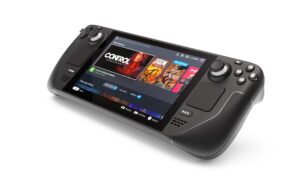
We’re gearing up for Steam Deck, and in the process we are finally starting to turn the RetroArch Steam version into something more than just a plain port (courtesy of Mats).
We came up with a SteamWorks shim that allows RetroArch Steam to interface with the Steamworks API. Mist, our middleware tool, runs in a separate process, runs concurrently wtih RetroArch Steam, and functions as a bridge between this separate process interfacing with Steamworks and the GPL application itself running in an entirely different process. This is 100% GPL compliant and the same approach has been employed by numerous other examples on Steam, including the aforementioned Icculus.
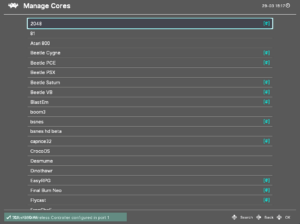
Thanks to Mist, here are some of the big new features for Steam users (and in particular, Steam Deck users):
- You can now install and uninstall cores directly from inside RetroArch by going to ‘Manage Cores’ from inside the menu. No longer do you have to manually browse Steam with your webbrowser and download random core DLCs for RetroArch, you can do it from within the convenience of the app running itself.
- On Steam Deck, the native OSK (Onscreen Keyboard) will appear now instead of the RetroArch default OSK. This should give a more seamless experience. We have decided against enabling the Steam OSK with Big Picture since it seems partially broken and instantly dismisses itself (or at least those were our testing results on a Steam Deck).
As a result of these changes, the Steam port is starting to become its own thing rather than just a straightforward no-frills port of the Windows/Linux versions.
Improved audio sample pacing / latency in many cores
Big improvements have been made to several cores concerning improved audio latency and audio sample pacing.
Not only should performance be better, but you should also be able to lower audio latency buffers now while still getting perfect sound.
Here are some of the cores that have received work recently on this front:
- Cannonball
- Flycast
- Gambatte
- Nestopia
- Snes9x
- Snes9x 2002
- Snes9x 2005
- Snes9x 2010
- SwanStation
- UAE
- VICE
For example, frame time deviations in a core like Snes9x 2010 are now extremely low with a default 64ms audio buffer. We measured 0.4 to 0.3% deviation, and this figure could likely be optimized even further by fiddling some more with audio buffer latency, or changing the audio driver.
Other measures have also been taken to further improve audio latency. Some cores have been updated now so that audio gets pushed to the frontend (i.e. RetroArch) AFTER the video frame has been uploaded. This is just in case the audio upload blocks for too long due to audio processing and syncing performed by the frontend. Uploading the video frame as soon as possible after the emulation loop is generally a good idea since it potentially avoids unnecessary input latency.
Steps have also been taken in cores to minimise use of the audio batch callback (for example, Tyrquake and Snes9x 2010), leading to better audio sample pacing, less overhead and better overall performance.
For Miyoo users
The following cores have been added for Miyoo platform users:
- BlueMSX
- ECWolf
- FCEUmm
For OpenDingux users
The following cores have been added for OpenDingux platform users:
- Dinothawr
- NXEngine
- XRick
UI/UX improvements
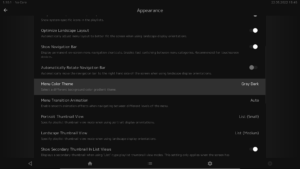
RGUI, MaterialUI and Ozone menu drivers now have new color themes. ‘Gray Dark / Gray Light’ themes have been added.
For XMB users, vertical fade adjustments have been made so that it functions a bit better like the original. Title margin can now also be adjusted, so that the title won’t cut off anymore on display devices with overscan (i.e. CRT TVs).
For RGUI users, 6×10 extended ASCII and Latin Extended A and B fonts have been added. These will enable most Latin alphabets to be displayed in RGUI.
For Ozone users, a thumbnail scaling option has been added (Settings->User interface->Appearance). This option scales the size of the thumbnail sidebar, which in turns means the thumbnails are scaled along with it. It should scale the thumbnails so that they should fill up more screen real estate now in the right sidebar. See the picture below for an example.
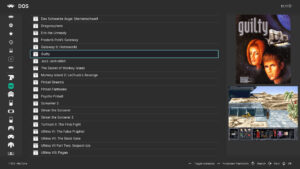
Manage Input Remapping Files
1.10.2 adds a new Manage Remap Files submenu to Quick Menu > Controls:
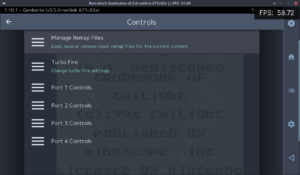
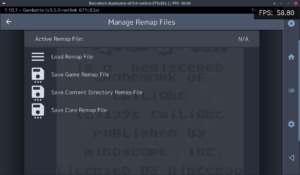
This updates correctly in real-time (the previous save/remove remap menu entries do not…), and only shows relevant options. When removing a remap, existing files are re-scanned and the one with the next highest priority (if found) will be loaded.
In addition, the currently active remap file will be saved automatically when closing content – i.e. it is no longer necessary (or indeed possible!) to save the file manually after each change.
We have also added a new Reset Input Mapping entry under Quick Menu > Controls > Manage Remap Files:
We have also fixed a nasty bug that could cause remap file corruption (incorrect or unwanted entries) when saving a remap after resetting one or more binds.
Prevent ‘global’ configuration of input libretro device type
Before, RetroArch allowed the input ‘libretro device type’ to be set globally per-user. This was nonsensical for a couple of reasons:
- Input device type has no meaning unless a core is actually running, so the option to set it globally does nothing but confuse users
- A global device type may be set that is incompatible with cores, leading to disabled input in-game. e.g. setting the global type to ‘RetroPad with Analog’ breaks Beetle PSX, since that is not a valid device type recognised by the core
1.10.2 fixes the issue by:
- Removing the global option Settings > Input > Port N Controls > Device Type (device type can now only be set while a core is running, via Quick Menu > Controls > Port N Controls)
- Ensuring that the ‘global’ device type is reset to the default RETRO_DEVICE_JOYPAD on startup and when closing cores (unless a device type override is set via the existing command line interface)
Note that device type is no longer stored in the main RetroArch config file, only in input remap files.
WiiU – Optimize for Gamepad
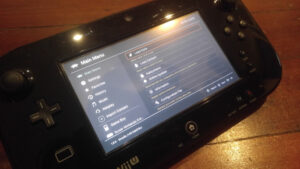
RetroArch WiiU adds a new option (Settings -> Video -> Output -> Optimize for GamePad). When enabled, it uses a 960p viewport if the user is on either 720p or 1080p (if they’re on 480p, they’re already optimized for GamePad). It defaults to off, so the native TV resolution is still preferred out of the box.
Explanation
The Wii U is a weird case with RetroArch because of the two screens (TV and Wii U GamePad). The Wii U can be configured to output video at 480p, 720p or 1080p (or interlaced equivalents), whereas the GamePad has a native 480-line display. While it is possible to send different images to the TV and GamePad, RetroArch currently sends the same image to both. This creates a bit of a conundrum as 480 does not divide evenly into any of the other available resolutions.
When running 240p content, setting the Wii U to 720p just works, because a 3x integer scale (240*3 = 720) on the TV also happens to be a 2x integer scale (240*2 = 480) on the GamePad. However, when running 480p content, having the Wii U set to 720p will result in a poor image all around, with non-integer scaling from 480->720 on the TV, and then even worse, 480->720->480 on the GamePad.
Running the Wii U at 1080p, you get the worst of all worlds. Absolutely nothing divides evenly into 1080, so no matter what content you’re playing, you’ll need either large borders or a filter/shader to stretch to that non-integer resolution, and putting that 1080p image back on the 480p GamePad makes it even worse again. Many users only use 720p because of the poor results you get from 1080p currently.
By running 1080p with a 960p viewport, you can do things like a 4x integer scale of 240p content which becomes a 2x integer scale on the GamePad, or a 2x scale of 480p content which becomes a 1x native display on the GamePad. Even more exotic resolutions like the Game Boy Advance (160p) are enhanced, with 160 dividing 6x into 960 or 3x into 480. This one change makes 1080p a lot less useless on Wii U.
- when “Optimize for Gamepad” is OFF: use the system output resolution (previous behavior)
- when “Optimize for Gamepad” is ON, pick the closest resolution based on the system resolution
And more
Not listed here of course are all the countless improvements made to individual cores since the last version. We might go into more detail on that sometime later, but rest be assured that cores are updated on a daily basis and receive heavy improvements, so keep updating your core library to get the latest benefits at all times!
Changelog
1.10.2
- 3DS: Add a menu toggle for switching between old and new 3DS speeds, located in the ‘Power Management’ menu. Enabled by default, hidden on old 3DS devices.
- AUDIO/MIXER: Free audio voices properly
- CHEEVOS: Update to rcheevos 10.3.3
- CHEEVOS: Support for Arduboy
- CHEEVOS: Fix tab sequences in rich presence being turned into t character
- CHEEVOS: Fix overflow when parsing float value that has more than 9 digits after the decimal
- CHEEVOS: Fix memory mapping when disconnect mask breaks a region into multiple blocks
- CORES: Enable manual selection of which cores are displayed in the ‘Standalone Cores’ menu
- DATABASE/EXPLORE: Added more categories to the Explore menu
- INPUT: Fix analog stick not working with ‘Unified Menu Controls’
- INPUT/MAPPING: Add ‘Manage Remap Files’ submenu + automatically save input remaps when closing content
- INPUT/MAPPING: Add ‘Reset Input Mapping’ option to ‘Manage Remap Files’ menu
- INPUT/MAPPING: Fix keyboard device remap nulling
- IOS/IOS13+: Support a toolbar that allows toggling of onscreen keyboard and touch mouse
- LIBRETRO: RETRO_ENVIRONMENT_SHUTDOWN fix – ensure core is properly unloaded when RETRO_ENVIRONMENT_SHUTDOWN is called
- LIBRETRO: RETRO_ENVIRONMENT_SHUTDOWN fix – ensure menu stack is properly flushed when RETRO_ENVIRONMENT_SHUTDOWN is called
- LINUX/MALI FBDEV: Fix segfault switching video threaded from quickmenu
- LOCALIZATION: Add Czech language support
- MMAP: Handle disconnect bits on both sides of len
- MIYOO: Improve CPU architecture and model name identification for Miyoo
- MENU/SETTINGS: Remove ‘Advanced Settings’ flag from ‘Settings > Core’ menu
- MENU/MATERIALUI: Add ‘Gray Dark + Light’ themes
- MENU/RGUI: Add 6×10 extended ASCII and Latin Extended A and B fonts. These will enable most Latin alphabets to be displayed in RGUI.
- MENU/RGUI: Add ‘Gray Dark + Light’ themes
- MENU/XMB: Add title margin adjustment
- MENU/XMB: Vertical fade corrections
- MENU/OZONE: The size of the thumbnail bar can now be changed though a new option (Settings->User interface->Appearance) up to double its normal size.
- MENU/OZONE: Add ‘Gray Dark + Light’ themes
- MENU/OZONE: Add thumbnail scale option
- HOTKEYS: Added hotkey for toggling sync to exact content framerate
- HOTKEYS: Prevent log spam when using rewind hotkey with cores that don’t support rewind, if rewind functionality itself is disabled
- HOTKEYS: Add hotkey for toggling sync to exact content framerate
- PS3/PSL1GHT: Add RSX graphics support
- PS3/PSL1GHT: Add libco support
- PS3/PSL1GHT: Add experimental PSMove support
- RS90: Optimise layout of sdl_rs90_video
- STEAM: Use native OSK (Onscreen Keyboard) instead of built-in RetroArch version
- STEAM: New built-in core DLC downloader
- STEAM: Swap OK/Cancel buttons by default
- VIDEO/HDR: Removed redundant copy of buffer in HDR mode if the shader has already a HDR format i.e. R10G10B10A2 (updated Vulkan/D3D11/D3D12 drivers)
- VIDEO/HDR: Fixed crash when using stock shader and HDR and previous optimisation
- WAYLAND: Dynamically load libdecor at runtime
- WAYLAND: Fix splash screen when using xdg_toplevel
- WAYLAND: SHM anti-collision for the splash screen
- WAYLAND: Skip splash screen if window is not ready
- WII: Fix find_connection_entry(): needs unsigned int Otherwise the USB gamepad cannot be found, if VID/PID has leading zero. This issue happened with Retrode gamepad adapter
- WII: Rework Retrode gamepad implementation to support multi_pad interface
- WII: Fix – Unplugging and re-plugging now works again
- WII: vWii- Only gamepad 1 is supported, because multi_pad is currently only relevant in the Wii U implementation
- WIIU: Implemented the multi_pad interface according to input/connect/connect_wiiugca.c
- WIIU: Add Optimize for Gamepad option
- WIIU: Fix USB gamepad support

